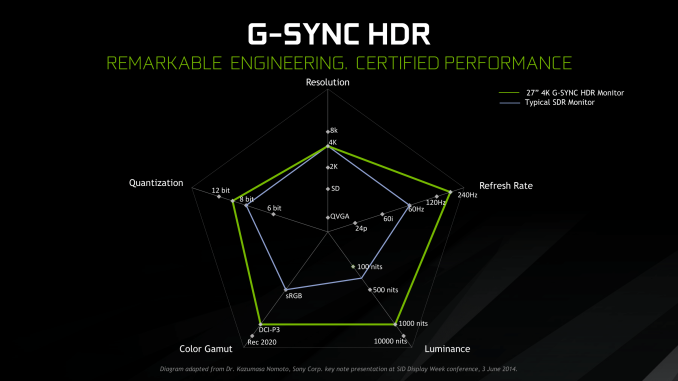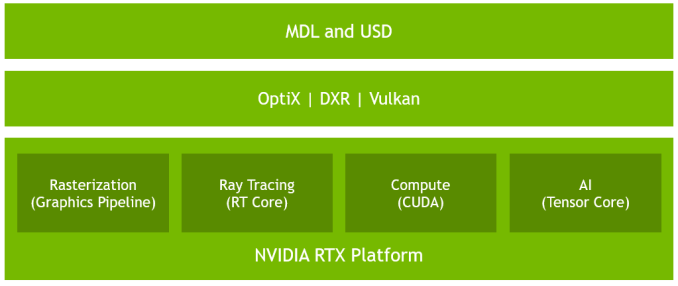The NVIDIA GeForce RTX 2080 Ti & RTX 2080 Founders Edition Review: Foundations For A Ray Traced Future
by Nate Oh on September 19, 2018 5:15 PM EST- Posted in
- GPUs
- Raytrace
- GeForce
- NVIDIA
- DirectX Raytracing
- Turing
- GeForce RTX
Meet The New Future of Gaming: Different Than The Old One
Up until last month, NVIDIA had been pushing a different, more conventional future for gaming and video cards, perhaps best exemplified by their recent launch of 27-in 4K G-Sync HDR monitors, courtesy of Asus and Acer. The specifications and display represented – and still represents – the aspired capabilities of PC gaming graphics: 4K resolution, 144 Hz refresh rate with G-Sync variable refresh, and high-quality HDR. The future was maxing out graphics settings on a game with high visual fidelity, enabling HDR, and rendering at 4K with triple-digit average framerate on a large screen. That target was not achievable by current performance, at least, certainly not by single-GPU cards. In the past, multi-GPU configurations were a stronger option provided that stuttering was not an issue, but recent years have seen both AMD and NVIDIA take a step back from CrossFireX and SLI, respectively.
Particularly with HDR, NVIDIA expressed a qualitative rather than quantitative enhancement in the gaming experience. Faster framerates and higher resolutions were more known quantities, easily demoed and with more intuitive benefits – though in the past there was the perception of 30fps as cinematic, and currently 1080p still remains stubbornly popular – where higher resolution means more possibility for details, higher even framerates meant smoother gameplay and video. Variable refresh rate technology soon followed, resolving the screen-tearing/V-Sync input lag dilemma, though again it took time to catch on to where it is now – nigh mandatory for a higher-end gaming monitor.
For gaming displays, HDR was substantively different than adding graphical details or allowing smoother gameplay and playback, because it meant a new dimension of ‘more possible colors’ and ‘brighter whites and darker blacks’ to gaming. Because HDR capability required support from the entire graphical chain, as well as high-quality HDR monitor and content to fully take advantage, it was harder to showcase. Added to the other aspects of high-end gaming graphics and pending the further development of VR, this was the future on the horizon for GPUs.
But today NVIDIA is switching gears, going to the fundamental way computer graphics are modelled in games today. Of the more realistic rendering processes, light can be emulated as rays that emit from their respective sources, but computing even a subset of the number of rays and their interactions (reflection, refraction, etc.) in a bounded space is so intensive that real time rendering was impossible. But to get the performance needed to render in real time, rasterization essentially boils down 3D objects as 2D representations to simplify the computations, significantly faking the behavior of light.
It’s on real time ray tracing that NVIDIA is staking its claim with GeForce RTX and Turing’s RT Cores. Covered more in-depth in our architecture article, NVIDIA’s real time ray tracing implementation takes all the shortcuts it can get, incorporating select real time ray tracing effects with significant denoising but keeping rasterization for everything else. Unfortunately, this hybrid rendering isn’t orthogonal to the previous concepts. Now, the ultimate experience would be hybrid rendered 4K with HDR support at high, steady, and variable framerates, though GPUs didn’t have enough performance to get to that point under traditional rasterization.
There’s a still a performance cost incurred with real time ray tracing effects, except right now only NVIDIA and developers have a clear idea of what it is. What we can say is that utilizing real time ray tracing effects in games may require sacrificing some or all three of high resolution, ultra high framerates, and HDR. HDR is limited by game support more than anything else. But the first two have arguably minimum performance standards when it comes to modern high-end gaming on PC – anything under 1080p is completely unpalatable, and anything under 30fps or more realistically 45 to 60fps hurts the playability. Variable refresh rate can mitigate the latter and framedrops are temporary, but low resolution is forever.
Ultimately, the real time ray tracing support needs to be implemented by developers via a supporting API like DXR – and many have been working hard on doing so – but currently there is no public timeline of application support for real time ray tracing, Tensor Core accelerated AI features, and Turing advanced shading. The list of games with support for Turing features - collectively called the RTX platform - will be available and updated on NVIDIA's site.













337 Comments
View All Comments
darkos - Friday, September 21, 2018 - link
Please add flight simulation testing to your list of applications. eg: X-Plane, Prepar3d.Vinny DePaul - Friday, September 21, 2018 - link
I am still rocking 980 with fps over 60 and everything turned up to max. I guess I will wait.mapesdhs - Thursday, September 27, 2018 - link
That's a perfect summary of why tom's looney article was so bad. If your current hw is doing just fine for the games you're playing atm, then upgrading makes no sense. It's rather cynical of NVIDIA, and some tech sites, to basically create a need and then push people into thinking they're idiots if they don't upgrade, while hiding behind very poor price/performance dynamics.DARK_BG - Friday, September 21, 2018 - link
As someone working in the game industry for already 8+ years I can tell you only one thing.No body will rush to implement proprietary features!The ones that have demos or are about soon to have the features implemented are the ones Nvidia reached to not vise versa.
This days making a game is no different than making any other product on this planet.It is corporate bussines which means you want maximum profit which translates in maximum user coverage which translates in maximum platforfm coverage PC (Windows , Mac , Linux), Consoles and mobile.
There is just no basis to anyhow compare Vulkan to anything proprietary.Vulkan is coming with the promise that what i make will look and feel the same way visually across multple platforms without requiring too much husstle on the development side.Even when you use a flexible engine as UE4 it is not that easy to have the same stuff working across multiple platforms and changes and further development for materials and meshes are required to have the stuff atleast to look indetical.
So i can hardly imagine that while you are bogged down with tons of bugs and trying to deliver your product across multiple platforms you will add yourself one more pain in the ass as nVidia Ray Tracing that will have doubfull income effect on your title given the small user reach.
I can give you Wargaming and Valve games as an example of old engines that are making tons of money.
So while nVidia is trying to ripoff people with that amount of money I'm wondering how to optimise one level so it could run fast and look cool on 6 years old midrange hardware.
eddman - Friday, September 21, 2018 - link
*off-topic*Although it is true that proprietary features do not always take off in a meaningful way (the GPU-accelerated mode of physx as an example), it doesn't mean an open standard would always be the popular choice.
Take big budget games from large publishers. These games, in the large majority of cases, are only available on three platforms, PS, xbox and windows, because these are the platforms that have the hardware to support such games and also have the largest audience.
IINM, vulkan is not available on X1 and PS4. If a AAA game dev was to use vulkan on windows, they'd still need to code the game for directx on X1 and GNM or GNMX on PS4, meaning they'd have to support three APIs.
If they go with directx on windows, then two platforms will already be covered and they'd only need to do additional coding for PS4 support.
On the other hand, vulkan does make sense for devs of smaller games where they want to cover as many platforms as possible, specially for mobile games, where vulkan covers windows, linux, mac, android and I think ios and even switch.
eva02langley - Friday, September 21, 2018 - link
Yes and no, for example Freesync is finally getting support from TV makers. Finally, I can get a 4k big screeen with HDR and... freesync.Open source is the way to go over proprietary technology.
eddman - Friday, September 21, 2018 - link
That's why I wrote it's not always the case. Sometimes it works, sometimes not. It all has to do with the standard having industry support. Being open source does not automatically mean it'd catch on, unfortunately.noone2 - Friday, September 21, 2018 - link
Someone will and it will be great and then it will catch on. Or maybe it won't, but that's how things happen. Someone takes a risk and it pans out. Either contribute to it or don't, play safe or take a chance.Nvidia has obviously been making some pretty good decisions over the years and has turned out some amazing products. Sometimes they've been wrong, but more often than not they are right. If they were wrong more than not, they'd be out of business, not a $150B company.
If you don't ever take a risk doing something new or cutting edge, you'll disappear. This is true for all technology.
noone2 - Friday, September 21, 2018 - link
Oh, and remember, at some point you don't have to care about 6 year old hardware. Look at consoles. At some point the studio just stops making a game for the last-gen, even though the new gen doesn't have the same size install base yet. Or a non-franchise game just shows up for next-gen and that's it. They never even bother to attempt to make it on older stuff.eva02langley - Friday, September 21, 2018 - link
Thanks for your comment, this was my argument all along.The only way to force a new feature is by shear numbers. Basically, if RTX was something available on new consoles, then that would make a business stand point sense, however AMD is owning consoles and might for a long term.
AMD should force multi-GPU via Infinity Fabric through consoles. This would work because devs would have access to additional power on the die via proper coding... and this delivered to 100% of the user base.
If this is only developed for less than 1% of the PC user base, this will fail miserably and nobody would add support unless sponsored by Nvidia themselves.
Financial analysts are seeing it and downgrades are coming.